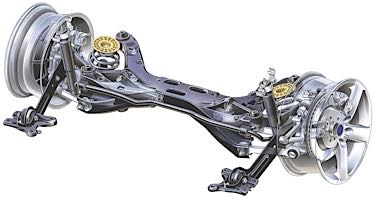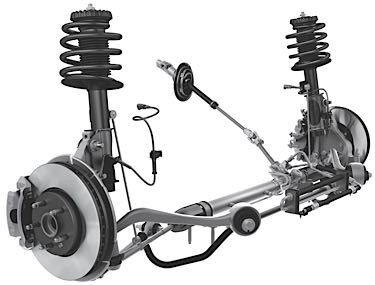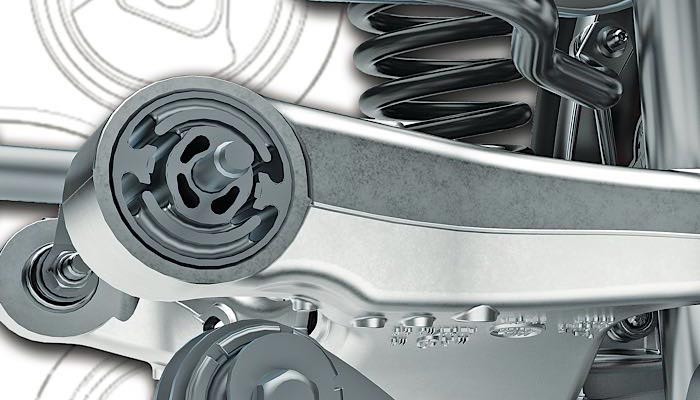Ac cording one recent tire dealer survey of the top tire sizes sold, only one 15-inch size cracked the top 10. Since tires are changing and not the roads, something has to give.
cording one recent tire dealer survey of the top tire sizes sold, only one 15-inch size cracked the top 10. Since tires are changing and not the roads, something has to give.
These stock wheel and tire packages with less sidewall are being use to reduce hysteresis losses that lead to rolling resistance. If there is less sidewall to flex, less fuel is consumed by the engine to flex the sidewall.
Another side benefit of lower profile tires is that is improved handling and braking performance. With less sidewall, something has to be able to take the punishment. On many late-model vehicles, the bushings on the control arms and suspension links have gotten larger and smarter.
Old Bushings
Back in the day, bushings were nothing more than insulation that prevented vibrations from passing through the suspension component to the body or frame. These bushings contained very little rubber. The main parts of the bushing were the metal inner and outer shells.
When older-style bushings failed, it usually resulted in metal-to-metal contact as the suspension moved. The customer would bring the vehicle into the shop when they could no longer stand the noise or vibration. Typically, tire wear issues were minimal.
Modern Bushings
When rims have larger diameters, the wheel assembly weighs more because rubber and air have been replaced with metal. This extra weight means that the springs and bushings have to control more mass. This mass is not constant. As the wheel assembly hits bumps, it accelerates upwards with greater force. If the bushing or spring can’t control this movement and force, the suspension becomes fully compressed and damage can occur.
Most modern bushings augment the geometry of the suspension. As the vehicle loads the suspension, movement in the bushings can change the toe, camber and caster so that the vehicle is more stable under braking, cornering and acceleration. This all done without sacrificing tread life or fuel economy while traveling in a straight line.
Modern suspension bushings act like a progressive spring. As the bushing is loaded in different directions, the first few millimeters of movement might occur with very little effort. As the load increases, the bushing will become stiffer. Also, a control arm bushing may react different to loads caused by braking and those caused by side loads.
To have these progressive qualities, the structure of the bushing can be complex. You may see different structures, voids and materials in a bushing. Some of these voids may pass all the way through the bushing.
Some bushings may have chambers filled with oil. These are commonly called hydraulic bushings. As loads are put on, the suspension fluid will pass between the chambers. Since a fluid is not compressible like the soft components, movement of the suspension can be controlled in a more predictable manner. Also, the oil and chambers help to isolate the vibration and noise from the tires. When hydraulic bushings fail, they will leak oil.
With these advanced bushings, the alignment of the bushing is critical. A difference as little as 7 degrees in how the bushing is installed can change how the bushing operates. This can eventually lead to the premature failure of the bushing. Many bushings need to be tightened to the final torque specification with the suspension loaded. Failing to do this may result in damage to the new bushing. Also, weak springs and lower than specified ride height can cause the bushing to fail.
 Driver Complaints
Driver Complaints
A knocking noise is the most common complaint from drivers. The noise may occur during braking and acceleration. Often the noise will be noticed by the driver during low-frequency suspension movements like speed bumps and curbs.
Instability under braking and cornering is another symptom of a worn bushing. The driver may notice a change in steering inputs as the vehicle loads the suspension and moves. It is a “seat of the pants” feeling in which the steering goes from normal to soft and back very quickly. This is common on vehicles the have thrust links that extend from the front of the vehicle to the lower ball joint. The feeling in the wheel is caused by changes in the caster and toe.
The next most common symptom of bushing wear is tire wear. Worn bushings often cause a “toe in” condition as the vehicle travels down the road. In rear independent suspensions, worn lateral links can cause extreme cases of toe and negative camber. This leads to extreme inner edge tire wear. The customer may think that the tires are fine until one is punctured or they encounter slick road conditions.
Inspection
It is possible for a worn bushing to have alignment angles that are still within specifications. As the bushings fight against the forces of rolling resistance, braking and acceleration, weak bushings can cause the camber, caster and toe angles to change due to the size and placement of the bushings. This is why a visual inspection of the bushings can be critical. If any part of the bushing has separated or has been torn, it is grounds for replacement.
Ozone and extreme temperatures tend to destroy rubber bushings. Many bushings are subjected to high temperatures from the brakes. These temperatures can exceed engine and exhaust temperatures. Environmental damage of this kind will cause hardening of the materials and eventually cracking. As the cracks grow, it eventually will compromise the strength of the bushings. Some cracking is normal. Ford will often list in the service information how long and how deep a crack can be before replacement is required.
Advanced Diagnostics
Have you ever noticed a vehicle with one wheel that has a buildup of brake dust? It could be the thrust angle changed by worn bushing. This can occur on all vehicles with stability control, no matter the type of suspension design.
The thrust angle is an imaginary line drawn perpendicular to the rear axle’s centerline. This measurement compares the direction that the rear axle is aimed with the centerline of the vehicle. It also confirms if the rear axle is parallel to its front axle, and that the wheelbase on both sides is the same.
To the customer, an off thrust angle will mean an off-center steering wheel. To a stability control system, the increased steering angle and changes in yaw sensor readings could be seen as understeer. To correct the imaginary push, the ESC system will pulse the brakes for one wheel.
The customer may notice a momentary pull. You may notice a buildup of brake dust.














